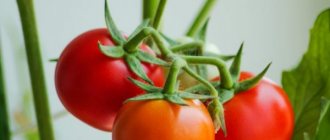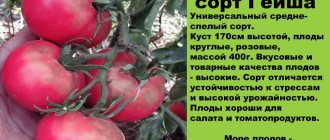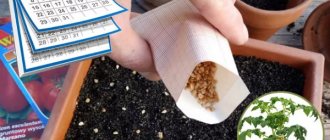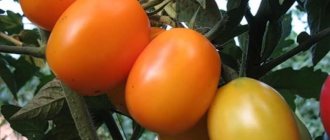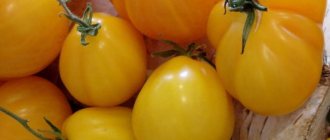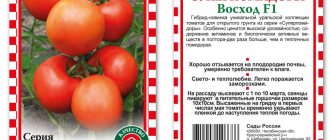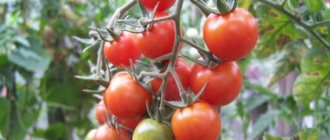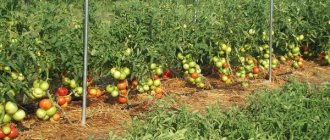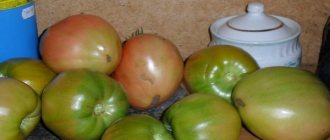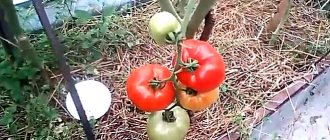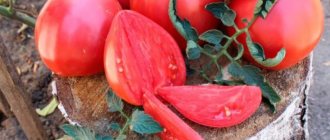There are tomatoes that are good everywhere - in salads and appetizers, pickled and dried, in juices and ketchups. These varieties include the universal Kalinka raspberry F1. The cultivar is suitable for experienced and novice gardeners due to its unpretentiousness and endurance.
| Height | Landing location | Ripening time | Fruit color | Fruit size | Origin | Fruit shape |
| short | Greenhouse, Open ground | Mid-season | Reds | Average | Variety | Round |
Tomato "Kalinka-Malinka": description of the variety
| Variety name | Kalinka Malinka |
| general description | Mid-season superdeterminate variety |
| Originator | Russia |
| Ripening period | 111-115 days |
| Form | Round |
| Color | Red |
| Average weight of tomatoes | 50 grams |
| Application | Universal |
| Productivity of the variety | 2.6 kg per square meter |
| Features of cultivation | Standard agricultural technology |
| Disease resistance | Disease resistant |
The Kalinka-Malinka tomato was bred by Russian breeders in the 21st century.
The Kalinka-Malinka variety is a mid-season tomato, since from the moment the seeds are planted to the moment the ripe fruit appears, it usually takes from 111 to 115 days. The height of the standard superdeterminate bushes of this plant is about 25 centimeters. They are covered with medium-sized dark green leaves.
This variety is not a hybrid and does not have F1 hybrids of the same name . It is suitable for growing in unprotected soil and under film covers, as well as in greenhouses.
This variety of tomatoes is highly resistant to diseases. The yield of this variety is good. About 2.6 kilograms of marketable fruits are usually harvested from one square meter of planting .
| Variety name | Productivity |
| Kalinka Malinka | 2.6 kg per square meter |
| Boni M | 14-16 kg per square meter |
| Aurora f1 | 13-16 kg per square meter |
| Leopold | 3-4 kg per bush |
| Sanka | 15 kg per square meter |
| Argonaut f1 | 4.5 kg per bush |
| Kibitz | 3.5 kg per bush |
| Heavyweight of Siberia | 11-12 kg per square meter |
| Honey cream | 4 kg per square meter |
| Ob domes | 4-6 kg per bush |
| Marina Grove | 15-17 kg per square meter |
On our website you will find a lot of useful information about growing tomatoes. Read all about indeterminate and determinate varieties. And also about the intricacies of caring for early ripening varieties and varieties characterized by high productivity and disease resistance.
Prevention of diseases and pests
Kalinka-raspberry exhibits high resistance to diseases. It is rarely affected by late blight.
If there are pests in the garden or garden, “fragrant” spraying is carried out to prevent infection of tomatoes. caterpillars that feed on plant juices .
Examples of compositions:
- Garlic tincture. It is prepared by infusing 250 g of garlic in four to five liters of water for several hours. The solution is sprayed onto tomato leaves.
- Tobacco solution. It is prepared from five liters of hot water and 200 g of chopped tobacco. Leave for 24 hours. After filtering, the bushes are sprayed.
If folk remedies are powerless and infection still occurs, insecticides such as Aktarin or Karbofos will help. Dosage - according to the manufacturer's instructions.
Important ! Observe safety precautions when working with insecticides: when spraying the solution on tomatoes, use a respirator and protective gloves.
Characteristics
The main advantages of Kalinka-Malinka tomatoes can be called:
- ease of cultivation;
- good yield;
- versatility in the use of fruits;
- good taste of tomatoes;
- disease resistance.
This variety has virtually no disadvantages.
This variety of tomatoes is characterized by the formation of simple inflorescences and the presence of joints on the stalks. The fruits on the bushes set abundantly and ripen at the same time.
This type of tomato is characterized by smooth, round fruits with a very dense consistency. Unripe fruits are light green in color and turn red when ripe.
They have a high dry matter content and good taste. Each tomato contains two to three nests.
The average fruit weight is 52 grams . They tolerate long-term storage well. The fruits of this type of tomato can be used for preparing fresh vegetable salads, pickling and whole-fruit canning.
You can compare the weight of the fruits of this variety with others in the table below:
| Variety name | Fruit weight |
| Kalinka Malinka | 50 grams |
| Explosion | 120-260 grams |
| Crystal | 30-140 grams |
| Valentina | 80-90 grams |
| Baron | 150-200 grams |
| Apples in the snow | 50-70 grams |
| Tanya | 150-170 grams |
| f1 favorite | 115-140 grams |
| Lalyafa | 130-160 grams |
| Nikola | 80-200 grams |
| Honey-sugar | 400 grams |
Bush care
A characteristic feature of the variety is its unpretentiousness in care. However, to get an excellent harvest, you just need to follow these recommendations:
- Tying and pinching need not be carried out;
- Fertilize three to four times a season using organic and mineral fertilizers;
- Water the plantings regularly, but moderately;
- Since, due to their short stature, tomato bushes suffer from scorching sun rays, they must be covered with spandball;
- Mulching will help protect the crop from drought, reliably retaining the necessary moisture. Hay and straw are good for mulching.
ATTENTION: Start mulching as soon as the soil warms up well.
Recommendations for cultivation
These tomatoes can be grown in any region of the Russian Federation. Sowing seeds for seedlings should be done 50-60 days before you plan to plant the plants in a permanent place.
In order for the seeds to germinate faster, you need to maintain the air temperature in the room in which the containers with them are located at 23-25 degrees Celsius.
When planting in the ground, no more than five plants should be placed on one square meter of land . This variety does not require staking or pinching.
The main measures for caring for these tomatoes include regular watering and fertilizing with complex or mineral fertilizers. If you want the seeds to germinate faster, the plants to be healthier, and the fruits to set better, you can use special plant growth and development stimulants.
Planting and care
Under such conditions, the bushes will be neat, miniature, compact. They are not able to break from gusts of strong wind or heavy rain. To save low-growing tomato bushes from the soil-drying heat, the plantings must be mulched. Hay, straw, and pine needles are used as mulch material. Lay out the selected material in a layer of six to eight centimeters after watering so that the root collar remains free.
Since the leaves of the vegetable plant are active in relation to photosynthesis, the productivity of the tomato increases many times. Therefore, the Malinka variety is suitable for growing in fields. It’s no wonder that farmers’ reviews of planting and caring for low-growing tomatoes are excellent. They note that they are ideal for mechanized cultivation. And thanks to its resistance to cold and disease, the standard type of tomato ensures consistently high yields of tasty and juicy fruits.
To grow seedlings, use peat cups or other containers. A little rotted manure is added to the soil - no more than 1/3 of the volume of soil in the container. Sow seeds at the end of February. Before this, they must be soaked in warm water (20-25 0C) for 18 hours. Dried seeds are deepened 1 cm into the soil. Then water a little with warm water.
In mid-April, the plant can be planted in a greenhouse, and in open ground a few weeks later, when the threat of frost has passed. Seedlings are planted up to 5 pcs per 1 sq. m.
Note! The plant has a compact root system. If the plot is small or the greenhouse is small, you can plant many Malinka tomato bushes without fear of competition for space and food
The plant is not too branchy, so there is no need to shoot it. Due to the fact that tomato fruits have a beautiful crimson color, they are planted in pots to decorate the garden.
Tomatoes in pots
Important! It is imperative to loosen the soil as a crust forms on its surface. Fertilizing with mineral or organic fertilizers should be applied 3 times per season.
They can be alternated. Fertilizer is applied for the first time 3 weeks after planting in open ground. Subsequent feedings - every 2 weeks. To do this, you need to dissolve 15 grams in a bucket of water. ammonium nitrate, 50 g
Fertilizing with mineral or organic fertilizers should be applied 3 times per season. They can be alternated. Fertilizer is applied for the first time 3 weeks after planting in open ground. Subsequent feedings - every 2 weeks. To do this, you need to dissolve 15 grams in a bucket of water. ammonium nitrate, 50 gr.
So, if you decide to plant a Malinka tomato, the characteristics and description of the variety will help you get a good harvest. You can grow tomatoes of this variety not only to obtain a tasty harvest, but also as an ornamental plant. Caring for the plant is simple, so even a novice vegetable grower can handle it.
Let's sum it up
The tomato variety “Kalinka-Malinka” does not require much care, which is why it is loved by Russian tomato growers. The basic rule of growing is regular watering. There is no need to tie or pin. The bushes are compact, low, and practically do not branch. They can be planted more densely. Even from a small garden bed a significant harvest is harvested.
source
There are tomatoes that are good everywhere - in salads and appetizers, pickled and dried, in juices and ketchups. These varieties include the universal Kalinka raspberry F1. The cultivar is suitable for experienced and novice gardeners due to its unpretentiousness and endurance.
| Height | Landing location | Ripening time | Fruit color | Fruit size | Origin | Fruit shape |
| short | Greenhouse, Open ground | Mid-season | Reds | Average | Variety | Round |

